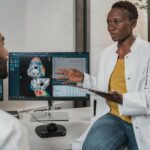In today’s world, medical advancements are continually pushing the boundaries of patient care. One such breakthrough that has revolutionized the field of healthcare is non-invasive medical imaging technology. This cutting-edge technology has transformed the way we diagnose and treat various medical conditions, providing a safer and more efficient alternative to invasive procedures. In this article, we will delve into the intricate world of non-invasive medical imaging technology, exploring its incredible impact on patient care and the exciting possibilities it holds for the future.

Non-Invasive Medical Imaging Technology
Medical advancements have paved the way for a revolutionary approach to patient care: non-invasive medical imaging technology. This innovative field has transformed the way medical professionals diagnose, treat, and monitor various diseases and conditions. Through a range of techniques such as computed tomography (CT), positron emission tomography (PET), ultrasound (US), photoacoustic imaging (PAI), and magnetic resonance imaging (MRI), non-invasive imaging has become an integral part of modern medicine.
Peering Inside the Human Body:
Structural imaging techniques like CT, MRI, and US provide invaluable insights into the anatomy and morphology of the body. With their ability to produce detailed images, these technologies enable healthcare professionals to visualize and evaluate structures like organs, tissues, vessels, and bones. As a result, diagnosis and treatment planning have become more accurate and efficient than ever before. In the realm of oncology, where patient management is critical, non-invasive imaging plays a vital role in determining the extent of the disease and monitoring treatment progress.
“By harnessing the power of non-invasive medical imaging technology, healthcare professionals can delve deep into the human body, unraveling the mysteries of disease with unmatched precision.”
Beyond Structure:
Non-invasive imaging goes beyond capturing anatomical details. It also provides functional and molecular data, offering a comprehensive understanding of a patient’s condition. Techniques such as PET and MRI allow medical professionals to analyze metabolic activity and blood flow, aiding in the detection and monitoring of diseases like cancer and neurological disorders.
The Advantages of Non-Invasive Approach:
Non-invasive medical imaging technologies have garnered immense popularity in research and development due to their low cost and convenience. These methods allow for repeated examinations without the need for invasive procedures, reducing patient discomfort and minimizing the risk of complications.
In the field of neuroimaging, researchers are constantly striving to refine and improve current techniques like MRI and PET/CT. By adopting a non-invasive approach, these technologies offer a window into the intricate workings of the human brain, aiding in the diagnosis and treatment of neurological conditions.
**Did you know?
MRI, a non-invasive imaging technology, captures detailed anatomical images in three dimensions, enabling healthcare professionals to explore the human body in unprecedented detail!”
Exploring New Frontiers:
The quest for higher resolution and specificity has led to the exploration of optical imaging techniques that utilize the near-infrared region of the wavelength spectrum. These novel methods hold the promise of even greater accuracy and precision in imaging various tissues and diseases. As research and technology continue to advance, we can expect non-invasive imaging to evolve even further, offering new opportunities for early disease detection and personalized treatment plans.
Molecular Imaging:
Non-invasive medical imaging technology encompasses not only structural and functional aspects but also molecular imaging. Techniques like magnetic particle imaging (MPI) are being developed to reveal intricate molecular processes within the body, allowing medical professionals to study the fundamental mechanisms of diseases at a cellular level. With ongoing research and refinements, molecular imaging holds tremendous potential for guiding targeted therapies and improving patient outcomes.
**Unleashing the power of non-invasive medical imaging technology allows healthcare professionals to dive deep into the invisible realm, illuminating the inner workings of the human body with unprecedented clarity and precision.”
Promising Innovations:
Researchers are continuously exploring new avenues to enhance the capabilities of non-invasive imaging technology. For instance, they are focused on developing advanced detector technologies for ionizing radiation used in CT scans. These innovations aim to minimize radiation exposure while maintaining high image quality.
Advantages
– Non-invasive imaging technology offers a safe and patient-friendly alternative to invasive procedures, reducing discomfort and complications.
– It provides accurate and comprehensive information about a patient’s condition, enabling healthcare professionals to make informed decisions.
– Non-invasive imaging technologies are cost-effective and convenient, making them suitable for large-scale screening and research purposes.
Cons:
– Certain non-invasive imaging techniques may have limitations in terms of resolution and specificity, requiring complementary approaches to obtain a complete diagnostic picture.
– Availability and accessibility of advanced imaging technologies may be limited in some healthcare settings or regions.
Embrace the Revolution:
Non-invasive imaging technology has revolutionized patient care, empowering healthcare professionals to uncover the hidden secrets of the human body. Through its use, we have witnessed remarkable strides in disease detection, diagnosis, and treatment monitoring. As research continues to push the boundaries of this field, we can only anticipate further breakthroughs that will continue to improve patient outcomes and transform the landscape of healthcare.
So, join the non-invasive medical imaging revolution and unlock a world of possibilities in patient care!
“In the realm of healthcare, non-invasive medical imaging technology has emerged as a beacon of hope, illuminating the path towards better diagnostics, personalized treatments, and ultimately, improved patient outcomes.”
Ultrasound waves have long fascinated scientists and researchers, and it’s not hard to see why. They hold a plethora of interesting facts just waiting to be discovered. From their ability to create images of the inside of the human body without invasive procedures, to their use in treating certain medical conditions, ultrasound waves are truly remarkable. If you’re curious to learn more about the captivating world of ultrasound waves, click here for a list of interesting facts: interesting facts about ultrasound waves. Prepare to be amazed by the wonders of this incredible technology.

FAQ
What is non-invasive imaging technology?
Non-invasive imaging technology refers to the use of various imaging techniques such as computed tomography (CT), positron emission tomography (PET), ultrasound (US), photoacoustic imaging (PAI), and magnetic resonance imaging (MRI) to obtain diagnostic information without the need for invasive procedures.
What are the benefits of non-invasive imaging technology in healthcare?
Non-invasive imaging technology provides a wealth of information encompassing anatomical, functional, and molecular data. It allows for the detection, diagnosis, and treatment monitoring of diseases without the need for invasive procedures, reducing patient discomfort and risks associated with surgery.
How is non-invasive imaging technology used in oncology?
Non-invasive imaging technology plays a crucial role in oncology for patient management. It enables the detection and staging of tumors, assessing treatment response, and guiding targeted therapies. Techniques like CT, MRI, PET, and ultrasound are commonly used in cancer care.
What advancements are being made in non-invasive neuroimaging?
Current MRI and PET/CT techniques are being developed for non-invasive neuroimaging. These advancements aim to provide detailed imaging of the central nervous system, aiding in the diagnosis and treatment of neurological disorders, such as brain tumors and Alzheimer’s disease.
Are there any emerging trends in non-invasive imaging technology?
Yes, there are emerging trends in non-invasive imaging technology. Researchers are exploring optical imaging techniques using the near-infrared region of wavelength for higher resolution and specificity. Furthermore, novel technologies like magnetic particle imaging (MPI) for molecular imaging and advanced detector technologies for ionizing radiation in CT scans are under development.
- Revolution Space: Disruptive Ion Propulsion Transforming Satellites - April 24, 2025
- Race Through Space: Fun Family Game for Kids - April 24, 2025
- Unlocking the Universe: reading about stars 6th grade Guide - April 24, 2025
















